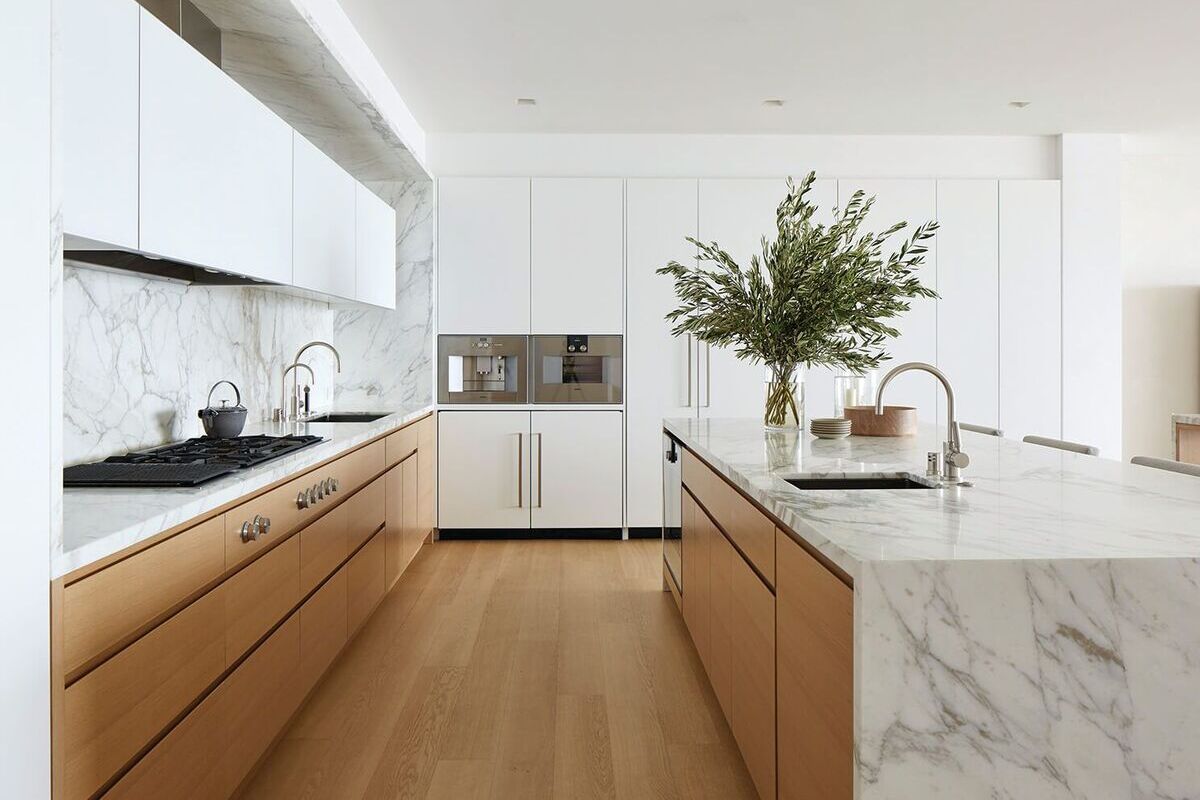Minimalist kitchen design is a timeless approach that focuses on simplicity, functionality, and efficiency, aiming to create an open, uncluttered space. With a minimalist design, the kitchen becomes more than just a functional space; it becomes a sanctuary of calm and beauty. This design style strips away excess, relying on essential elements, clean lines, and neutral colors. Below are some key features and ideas to create a minimalist kitchen.
1. Neutral Color Scheme
A neutral color palette is fundamental to minimalist design. Shades of white, gray, black, and beige create a serene and clean atmosphere. You can use white walls with gray or beige cabinetry, or even incorporate natural wood finishes for warmth. The focus should be on creating a cohesive and calm environment by using a consistent color scheme throughout the space. A neutral base allows for easy customization with accents, such as subtle touches of color in décor or plants.
2. Clutter-Free Counters
In a minimalist kitchen, countertops should be kept as clear as possible. Every item placed on the counter should have a purpose or be thoughtfully curated. This requires careful organization and storage solutions. For instance, all kitchen appliances, tools, and utensils that aren’t in constant use can be stored in drawers or cabinets to prevent visual clutter. A clean countertop contributes to the overall feeling of spaciousness and tranquility in the kitchen.
3. Integrated Appliances
One of the hallmarks of minimalist kitchens is integrated appliances that blend seamlessly with the cabinetry. Built-in refrigerators, dishwashers, and microwaves, for example, create a unified look and eliminate visual clutter. Appliances should be sleek, modern, and functional without drawing too much attention. Look for appliances with simple, flat fronts or designs that match the cabinetry for a seamless effect. The idea is to maintain the clean lines of the space without compromising on functionality.
4. Simple, Sleek Cabinets
Cabinets in a minimalist kitchen are often flat-fronted, with no visible hardware or intricate details. Handles and pulls can be hidden or reduced to simple, subtle designs. For instance, push-to-open mechanisms allow the cabinets to remain sleek and modern without the need for traditional hardware. Cabinet finishes should be matte or gloss, with materials like wood, metal, or high-quality laminate. The fewer the details, the more clean and visually expansive the kitchen feels.
5. Functional Lighting
Lighting in a minimalist kitchen plays an essential role in both function and ambiance. Overhead pendant lights, recessed lighting, or under-cabinet lighting are popular choices that offer practical and aesthetic benefits. Choose light fixtures with simple designs—think geometric shapes or clean lines—to keep the space feeling open and airy. The lighting should highlight key areas, such as the workspace or dining table, while also offering a soft glow to create a warm atmosphere. Natural light is also essential in a minimalist kitchen, so incorporate large windows or sliding glass doors to allow light to flood the space.
6. Maximized Storage
Minimalism thrives on smart and efficient storage solutions. Utilize every inch of available space to keep your kitchen organized and tidy. Built-in storage options like deep drawers, pull-out pantry shelves, or hidden pull-out racks for spices can help you achieve a clutter-free kitchen. Concealed trash bins, as well as pull-out trays for kitchen utensils, ensure that nothing is left out in the open. Multi-functional furniture like a kitchen island with built-in storage or a breakfast nook with hidden compartments can add both practicality and style.
7. Minimalist Backsplash
A minimalist backsplash should be subtle and not detract from the simplicity of the design. Classic options include plain white subway tiles, large-format tiles in a solid color, or even glass panels that blend seamlessly with the walls. For a modern twist, you could use a natural stone or concrete for a more industrial look. The key is to choose materials and colors that don’t compete with other elements in the kitchen.
8. Open Shelving
For a more airy feel, open shelving can be incorporated into a minimalist kitchen. However, open shelves require careful organization to avoid clutter. Keep items like neatly arranged plates, glassware, or small kitchen appliances on display, but avoid overcrowding the shelves. The key to open shelving in a minimalist design is to select a limited number of high-quality items that complement the overall aesthetic of the kitchen.
9. Simple Fixtures and Hardware
The fixtures and hardware used in a minimalist kitchen should have clean, simple lines and modern finishes. Choose faucets with sleek designs in finishes like matte black, brushed nickel, or polished chrome. The handles and knobs should be subtle, or you can opt for integrated push-to-open systems that eliminate the need for hardware altogether. The goal is to maintain a consistent, streamlined look without drawing attention to individual components.
10. Natural Elements
While minimalist kitchens often lean on industrial materials like concrete, metal, and glass, the inclusion of natural elements can soften the space and add warmth. Incorporating wooden accents in cabinets, shelving, or a dining table can create a nice contrast to the cooler, sleeker materials. Additionally, houseplants, such as succulents or small herbs, can bring life to the kitchen without adding clutter. Choose simple, modern planters that match the rest of the décor.
Conclusion
Minimalist kitchen design is about creating a functional yet aesthetically pleasing space where each element has a purpose. By focusing on neutral colors, clutter-free counters, integrated appliances, and clean lines, you can create a modern, organized kitchen that feels serene and welcoming. Remember that the key to a successful minimalist kitchen is balance—keeping everything simple while ensuring that the space meets your needs in terms of both function and style. Whether you’re designing a new kitchen or renovating an existing one, minimalist design principles will help you achieve a space that’s both timeless and practical.

